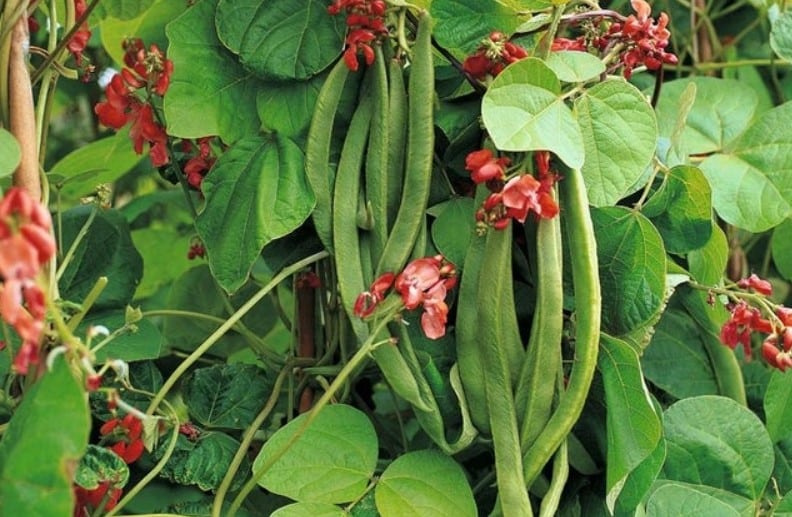Runner beans or Phaseolus coccineus, also known as scarlet runner, butter, or multiflora beans) is a legume in the family Fabaceae. However, the term may refer to Oregon lima beans, which belongs to a different species.
While mostly grown as ornamental plants, they also have uses in culinary where you may eat them green (eat whole young pod before it matures and becomes fibrous) as fresh as dried or fresh seeds. In Native Central America, some people eat their tuberous root too.

Can rabbits eat runner beans
No. Rabbits shouldn’t eat fresh or dried runner’s beans as they present a choking hazard, are unhealthy, and potentially toxic.
Yes, they are a good source of protein, fiber, folate, iron, potassium, magnesium, copper, thiamine, manganese, among other nutrients. However, they do contain phytohaemagglutinin (PHA) or hemagglutinin, which is destroyed during cooking. Unfortunately, we don’t give rabbits cooked foods.
While they don’t have much PHA like raw red kidney beans, they have a smaller amount, which if like if ingested in large amount, it may make blood clot in the digestive tract, damage intestinal walls, two things that will reduce normal nutrient absorption. Also, they may inhibit the hemagglutinin response of rabbits. (1)
Finally, nutritionally, they are high in carbohydrates and low in fiber, making them not a typical kind of food. Bunnies eat low carb, high fiber foods. High carbohydrates will alter microflora balance and cause stomach upsets. Also, they may contribute to obesity, and so on.
Runner green beans
Rabbits can eat runner green beans as a treat. They are safe. Give the one ½ to 1 this knife-shaped pods occasionally, like once or twice a week. They will make a good treat while providing variety to your rabbits.
Unlike mature beans, they are low in carbohydrates, higher in fiber, and a good source of vitamin A, C and K, folate, potassium, zinc, iron, and magnesium, among other nutrients.
While they do have a minimal amount of hemagglutinins, when fed as a treat, it is unlikely to cause any health issues. Besides, giving your rabbits a lot of any green beans is likely to cause gastrointestinal upsets – diarrhea, gas, and bloating since it is lower in fiber when compared to hay, which is the critical food for bunnies.
Fiber helps promote a healthy gut, keeps food flowing in their digestive tract, and helps wear down their ever-growing teeth.
Plant and sprout
You can feed runner bean sprout, stem, leaves, and flowers. You can make them part of the leafy greens they eat. It will be an excellent choice if you are looking for an option that is higher in protein. A packed cup of 5-6 different greens is enough for your two-pound bunny.
Even in the wild, beans are among the most favored plants, and bunnies are likely to cause a lot of damage to them, especially the tender leaves, shoots, and sprouts. They joint other plants that bunnies love like lettuce, peas, strawberries, grapes, carrot tops, beets, and so on.
Finally, don’t forget they are higher in calcium and protein, a reason why they shouldn’t be in their everyday meal.
Stick to the right diet
While they love them, don’t replace them with their regular diet. These beans should only be a part of the leafy salad mix you give them, which should be 10-15% of the food they eat. Otherwise, keep fresh hay at 80% or more, high fiber pellets at 5%, and treats shouldn’t exceed 5%.
Also, when offering your bunny the pods or leaves, ensure they are organic, begin with a small amount, and gradually increase it to give their tummy time to adjust to the new diet. Not doing so may cause stomach problems like diarrhea, gas, bloating, among others.
More on runner beans
Runner beans originated from the Mountains of Central America, mainly on Mexico and Guatemala, and they are widely grown as ornamental plants. While most have red flowers, a few have white ones, and their seeds are multicolored.
Some things that differentiate it from French or common beans (Phaseolus vulgaris) is that as they germinate, their cotyledons don’t pop from the ground, their root is tuberous, and their green pods have a knife-like shape.
Finally, some of the popular cultivars include Aeron Purple Star, Butler, Case Knife, Black Runner, Polestar, Scarlet Runner, Painted Lady, Pickwick Dwarf, Hammond’s Dwarf, and White Dutch Runner.
